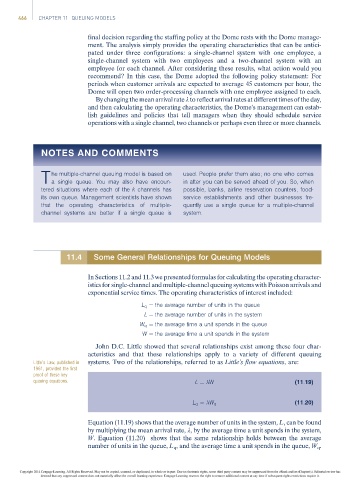Page 486 -
P. 486
466 CHAPTER 11 QUEUING MODELS
final decision regarding the staffing policy at the Dome rests with the Dome manage-
ment. The analysis simply provides the operating characteristics that can be antici-
pated under three configurations: a single-channel system with one employee, a
single-channel system with two employees and a two-channel system with an
employee for each channel. After considering these results, what action would you
recommend? In this case, the Dome adopted the following policy statement: For
periods when customer arrivals are expected to average 45 customers per hour, the
Dome will open two order-processing channels with one employee assigned to each.
By changing the mean arrival ratel to reflect arrival rates at different times of the day,
and then calculating the operating characteristics, the Dome’s management can estab-
lish guidelines and policies that tell managers when they should schedule service
operations with a single channel, two channels or perhaps even three or more channels.
NOTES AND COMMENTS
he multiple-channel queuing model is based on used. People prefer them also; no one who comes
T a single queue. You may also have encoun- in after you can be served ahead of you. So, when
tered situations where each of the k channels has possible, banks, airline reservation counters, food-
its own queue. Management scientists have shown service establishments and other businesses fre-
that the operating characteristics of multiple- quently use a single queue for a multiple-channel
channel systems are better if a single queue is system.
11.4 Some General Relationships for Queuing Models
In Sections 11.2 and 11.3 we presented formulas for calculating the operating character-
istics for single-channel and multiple-channel queuing systems with Poisson arrivals and
exponential service times. The operating characteristics of interest included:
L q ¼ the average number of units in the queue
L ¼ the average number of units in the system
W q ¼ the average time a unit spends in the queue
W ¼ the average time a unit spends in the system
John D.C. Little showed that several relationships exist among these four char-
acteristics and that these relationships apply to a variety of different queuing
Little’s Law, published in systems. Two of the relationships, referred to as Little’s flow equations, are:
1961, provided the first
proof of these key
queuing equations. L ¼ W (11:19)
L q ¼ W q (11:20)
Equation (11.19) shows that the average number of units in the system, L, can be found
by multiplying the mean arrival rate, l, by the average time a unit spends in the system,
W. Equation (11.20) shows that the same relationship holds between the average
number of units in the queue, L q , and the average time a unit spends in the queue, W q .
Copyright 2014 Cengage Learning. All Rights Reserved. May not be copied, scanned, or duplicated, in whole or in part. Due to electronic rights, some third party content may be suppressed from the eBook and/or eChapter(s). Editorial review has
deemed that any suppressed content does not materially affect the overall learning experience. Cengage Learning reserves the right to remove additional content at any time if subsequent rights restrictions require it.

